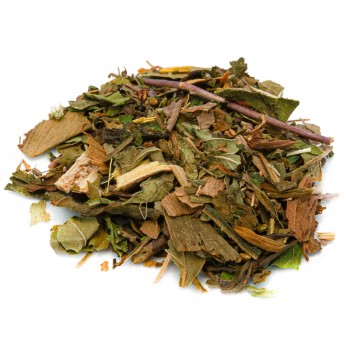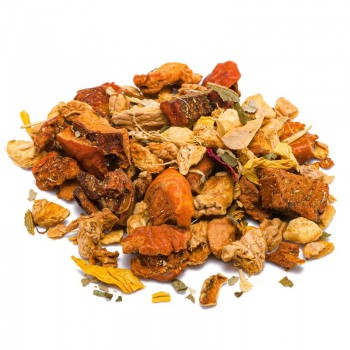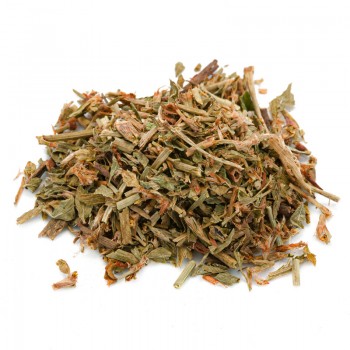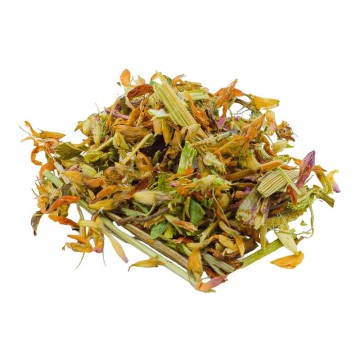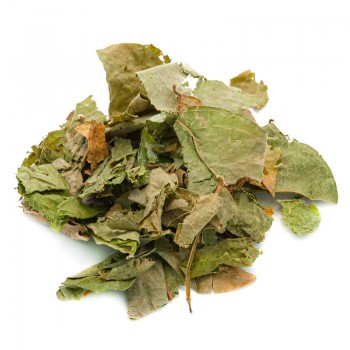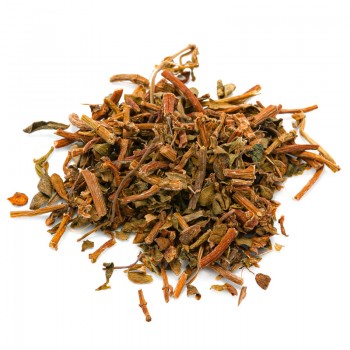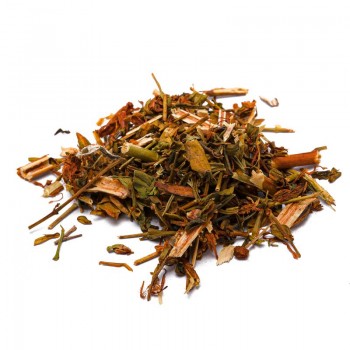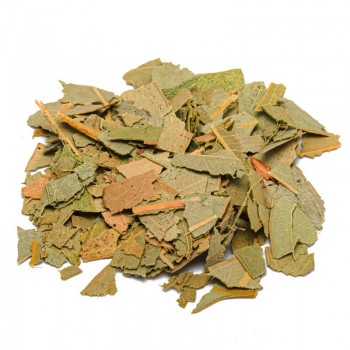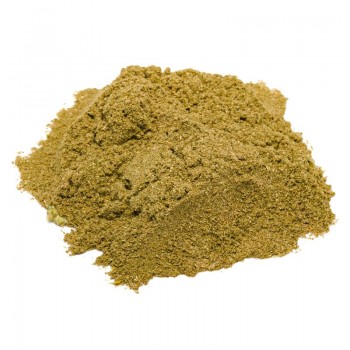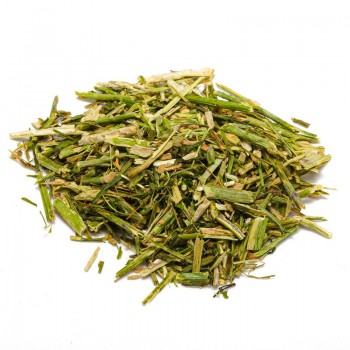When a cough occurs due to throat inflammation or other causes, it is common to seek relief from natural expectorants. These substances dilute and loosen mucus stuck in the lungs, making breathing easier and calming coughs.
Among the natural remedies, there are many expectorant officinal herbs that can be used, gathered in this blend, as a beneficial herbal tea for the bronchi and lungs.
The use of natural expectorants can provide relief from symptoms, and drinking plenty of fluids promotes hydration, which dilutes the mucus in the lungs.
The mix for the chosen expectorant herbal tea, contains herbs and vegetables such as: eucalyptus, sage, hyssop, rosemary, abrothan, mint, wildflower, fennel, blueberry leaves, oregano, pine , basil, lavender, mullein flowers, juniper.
Herbs with expectorant qualities: properties and benefits
Among the main components are those known as eucalyptus, sage, lavender and blueberry leaves. In addition, there are other particular herbs, with emollient and expectorant properties.
Sage is a medicinal herb known for its function as a natural expectorant, which soothes irritation due to ailments affecting the airways such as colds and coughs. Promotes the expulsion of mucus and phlegm, thanks to the active ingredients contained.
Eucalyptus acts both as a decongestant and as an expectorant. In the case of a persistent cough, an herbal tea or through fumenti is effective. Opens the lungs and promotes breathing, clears clogged nasal passages and relieves bronchial congestion. Eucalyptus is one of the best known cold remedies.
As an expectorant herb, hyssop is also known for its natural anti-inflammatory action. It is commonly used to soothe adverse respiratory conditions such as the flu, nasal irritation and congestion, colds and the early stages of bronchitis.
Contains active ingredients, such as thujone and other antioxidants, which favor its expectorant abilities. Also for sore throats and to calm coughs, as an antispasmodic herbal remedy, it thins phlegm and gives relief in treating asthma.
Another important ingredient is given by mullein flowers, often used in herbal teas to soothe sore throats and calm coughs. Mullein tones and relieves symptoms of sore lungs, promoting the healing of damaged tissues.
Wild thyme is also indicated in case of cooling, and as a soothing for lungs and bronchi in case of cough, pertussis and bronchitis. It acts as an anti-catarrhal and balsamic, helping to dissolve the phlegm and eliminate it.
A perhaps little known medicinal herb, which is part of this expectorant mixture, is abrothan or artemisia abrotanum. A plant that in ancient folk medicine was considered a natural antiseptic and was used to soothe the affections of the bronchi and lungs. The boiled leaves were a remedy that releases tannins, thujone and other substances, able to treat respiratory problems, especially relieving joint pain from the flu.
Mint is a flavoring and useful ingredient, as it contains a powerful compound called menthol. It favors the dissolution of phlegm, the dilution of mucus, helps to breathe more comfortably.
Pine is a plant known for its expectorant and fluidifying properties of bronchial secretions. Phlegm and mucus, which obstruct the respiratory tract, can be expelled through the combined action of this mixture, which also includes a precious ally such as Scots pine. It can also be useful as a herbal ingredient to soothe the symptoms of asthma, sinusitis and laryngitis.
Furthermore, among the expectorant herbs also present in the kitchen, fennel contains substances that help dissolve congestion and calm the dry and stinging cough of bronchitis.
Rosemary also has tonic and expectorant, antispasmodic and natural antiseptic properties.
Always among the spices that we use at the food level, oregano reserves effective properties as bechico, expectorant and useful as an antispasmodic to calm the attacks in spasmodic coughs, or in tracheitis from smoke. Basil, present in the herbal tea, is a useful tonic in case of cooling, cough, bronchitis and sinusitis. Both like andspectorant both to soothe the symptoms of rhinitis and excessive secretions, thanks to cineole.
This active principle is also present in lavender, and makes it useful in the expectorant herbal mixture, due to its fluidifying properties. It protects the respiratory system, calming the symptoms of coughs, bronchitis and laryngitis.
Other precious leaves are those of blueberry. Thanks to organic acids they support circulation, the immune system and help counteract the prolonged stress that the body undergoes during respiratory tract disorders.
Juniper also gives expectorant benefits, to remove nasal mucus and with an anti-catarrhal effect. A valid support for respiratory disorders such as stuffy nose, cough and sore throat.
Origins and History of cultivation
In the mixture of expectorant herbs, we find various medicinal plants, known in herbal medicine for centuries, for their beneficial action on the bronchi and lungs.
Many herbs have been used in this sense, both individually and in blends for herbal teas. Although some officinal herbs may come from different territories, most of them are native and widespread in Europe and Italy - except for the Eucalyptus of Australian origin.
The ingredients of the balsamic and expectorant herbal tea, today, are available dried and ready for infusion.
Plants and flowers
The components of the herbal tea are various, deriving from medicinal plants or shrubs known for their properties.
Eucalyptus botanical name of the eucalyptus, is an evergreen shrub whose habitat is given by the temperate zones of Australia. It belongs to the Mirtaceae family, and grows over 10 meters in height. It has a smooth bark, long stems and circular leaves.
The hyssop or Hyssopus officinalis , is a perennial plant of the Lamiaceae family. Many varieties are known, for medicinal and cooking herbs. It reaches up to 2 meters in height, has a thin stem, very fragrant purple-blue flowers.
The abrotano or Artemisia abrotanum is a perennial plant of the Composite family. It is native to southern Europe, and exhibits a cedar-like odor. It grows in uncultivated land reaching a height of about 1 meter, and has been used for centuries in herbal medicine - much appreciated by the ancient Greeks, and in the Middle Ages.
The Thymus serpyllum , known by the common name of wild or wild thyme, is a flowering plant of the Lamiaceae family. It is native to Europe and North Africa, now widespread in many territories. It shows a low shrub, growing with creeping stems up to 10 cm long. The oval leaves are evergreen, and the strongly scented flowers are lilac, pink-purple or magenta.
The fennel from the botanical name Foeniculum vulgare, is a flowering plant of the Apiaceae family (Umbelliferae). Native to the coasts of the Mediterranean, fennel has spread to many parts of the world, due to its food value. It grows well in arid soils, near the sea and on the banks of rivers.
The juniper from the botanical name Juniperus Communis is an evergreen conifer, small tree or shrub, of the Cupressaceae family. It provides the main ingredient for gin liqueur, and for various herbal treatments. It grows in different varieties, preferring the cold climates of the Northern Hemisphere.
The licorice from the botanical name Glycyrrhiza glabra, a perennial plant of the Fabaceae family. It produces small, purple to light blue flowers and displays long tap roots, reaching over one meter. These roots give the characteristic flavor ingredient we know as licorice.
Mint or Mentha is a perennial plant, belonging to the Lamiaceae family. It is widespread in many species, from 13 to 24 species, all with similar phytotherapy properties. Many hybrids and varieties of mint are renowned, mainly used for food.
The Pinus sylvestris , Scots or Scots pine, is a species of tree of the Pinaceae family. Native to Eurasia, it grows both at sea level and as a mountain tree up to over 2,000 meters. It shows short greenish-blue leaves and an orange-red bark.
The mullein or Verbascum thapsus , is una species native to Europe, northern Africa and Asia of the Scrophulariaceae family. It is a biennial plant that can grow up to 2 meters in height, with small yellow flowers, a long stem and a large rosette of leaves. It grows in different habitats, preferably on sunny grounds.
Salvia officinalis is a plant of the Lamiaceae family, in the Mentheae subfamily. It is native to the Middle East but widespread in our territories for millennia, for its healing and food properties. It grows up to 40-50 centimeters, with an extensive root system.
The rosemary plant is Salvia rosmarinus , a shrub of the Lamiaceae family. As a medicinal herb it is also known for the use of its leaves in cooking. It blooms from autumn to spring, with linear and very aromatic leaves, green on top and whitish below.
The basil from the botanical name Ocimum basilicum, is a herb known in the kitchen, belonging to the Lamiaceae family. It is native to the tropical regions of Central Africa and Southeast Asia, spread in different varieties and hybrids. The type commonly used as a flavoring is sweet basil (or Genoese basil).
oregano (Origanum) is a perennial herbaceous plant or shrub of the Lamiaceae family. Native to Europe, North Africa and temperate Asia, it grows spontaneously in open or mountainous terrain. It prefers sunny and arid soils, cultivated as an aromatic plant and for its phytotherapy properties.
The blueberry plant comes from evergreen dwarf shrubs, of the genus Vaccinium and part of the subgenus Oxycoccus. Vaccinium microcarpum or Oxycoccus microcarpus, Vaccinium oxycoccos or Oxycoccus palustris are present. They are widespread in North America and Chile, northern Europe and Asia.
lavender is a plant that has several varieties, and the most effective is the “true” lavender, Lavandula angustifolia Miller, of the Lamiaceae family. Native to Europe, it is very common in Italy as a small evergreen shrub. It shows greyish-green leaves and flowers gathered in spikes. It adapts to many terrains and latitudes, preferring sunny and not too windy areas.
Nutritional values of the expectorant herbal blend
This mix for expectorant herbal tea contains various active ingredients for the fluidification of phlegm and mucus.
The blend of herbs gives elements such as flavonoids, acids (rosmarinic acid, caffeic acid, carnosic acid), the precious cineol, thujone and tujanol, tannins and antioxidants .
How to use the herbal blend in the expectorant tea
The exact infusion is obtained by placing approximately 3-5 grams of the mixture of expectorant herbs with water at 100 ° C in a cup (250 ml).
Leave to infuse for 8 to 10 minutes, before drinking the herbal tea. Add honey or sugar if desired.
It is advisable to use this blend of expectorant herbs by inhaling the vapors of the infusion .
Blend of expectorant herbs: side effects and contraindications
The ingredients that make up the herbal tea are known and safe, but it is essential to keep the consumption of the herbal tea within the recommended doses.
The intake must be limited, also to avoid possible effects of gastric disturbances, laxative effects, nausea, vomiting, esophagitis and gastroesophageal reflux.
Due to the presence of substances that act on airway disorders, it is recommended to seek medical advice for those suffering from chronic diseases, viral infections and respiratory problems.
It is important to carefully view the herbs in the herbal tea, to consider possible allergies or intolerances to the individual ingredients .
The herbal tea is not recommended for pregnant and breastfeeding women.











 No reward points for this product.
No reward points for this product.
